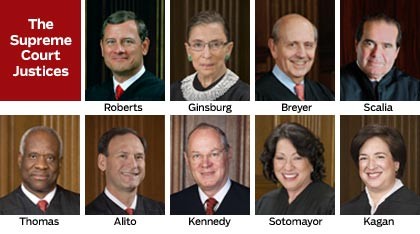
Democrat or Republican: The 2016 Election and The Supreme Court
By Christian Hakim, Staff Writer
Democrat or Republican? The notorious question that consumes everyone for about two years prior to a presidential election. For the upcoming 2016 presidential election the conversation is no different as candidates jockey for position; fighting over who is most conservative or liberal, respectively. However, this time everyone’s political passion is not just fueled by what comes with having your party atop of the Executive Branch—this election carries a lot of weight as to which party will have a majority in the Supreme Court of the United States.
By the time the 2016 President elect is sworn into office, three of the nine justices will be over the age of 80 [1]. This means there is a high possibility that our next president will nominate three justices during their term. Politics plays an important role in these nominations. As history goes, Republican presidents nominate conservative justices and Democratic presidents nominate liberal justices. Seems logical enough, right?
Here is a brief background of our Nine Justices as they stand today in an effort to help give better insight to the political theater that we are rapidly approaching:
- CHIEF JUSTICE; JOHN G. ROBERTS, JR. (60 years old, born January 27, 1955)
- Republican nominated by President George W. Bush as the Court’s Chief Justice and took his seat September 29, 2005 [2]
- ASSOCIATE JUSTICE; ANTONIN SCALIA (79 years old, born March 11, 1936)
- Republican nominated by President Ronald Reagan and took his seat on September 26, 1986 [2]
- ASSOCIATE JUSTICE; ANTHONY M. KENNEDY (79 years old, July 23, 1936)
- Republican nominated by President Ronald Reagan and took his seat February 18, 1988 [2]
- ASSOCIATE JUSTICE; CLARENCE THOMAS (67 years old, June 23, 1948)
- Republican nominated by President H. W. Bush and he took his seat on October 23, 1991. [2]
- ASSOCIATE JUSTICE; RUTH BADER GINSBURG (82 years old, March 15, 1933)
- Democrat nominated by President Clinton and took her seat August 10, 1993. [2]
- ASSOCIATE JUSTICE; STEPHEN G. BREYER (77 years old, August 15, 1938)
- Democrat nominated by President Clinton and took his seat August 3, 1994. [2]
- ASSOCIATE JUSTICE; SAMUEL A. ALITO, JR. (65 years old, April 1, 1950)
- Republican nominated by President George W. Bush and took his seat January 31, 2006. [2]
- ASSOCIATE JUSTICE; SONIA SOTOMAYOR (61 years old, June 25, 1954
- Democrat nominated by President Obama and took her seat August 8, 2009. [2]
- ASSOCIATE JUSTICE; ELENA KAGAN (55 years old, April 28, 1960)
- Democrat nominated by President Obama and took her seat August 7, 2010. [2]
The short of what this means is that we currently have five of the nine justices associated with the Republican party and each was appointed by a Republican president. The other four justices are Democrats, two being appointed by Clinton and two appointed by Obama. Thus, giving a Republican majority. The three oldest Justices, that many project will step down shortly, are Ruth Bader Ginsburg (Democrat), Antonin Scalia (Republican) and Anthony M. Kennedy (Republican).
The partisanship of the court plays a major role in how the courts decides on land mark issues. Chief Justice John G. Roberts has been at the helm for about ten years and has maintained a conservative court which tended to be pro-business and protective of free speech. [5]. In Citizens United v. Federal Election Commision, Roberts court ruled corporations could make unlimited independent expenditures in campaigns, saying restrictions violated free speech. [6]. There were other rulings that aligned with conservative ideals. For example, Robert’s conservative court made pro-guns decisions in McDonald v. Chicago and District of Columbia v. Heller. [6]. The upcoming decision from our presidential elect will play a huge role in the landmark cases that are set to hit the court in 2016 and there after.
As presidential campaigns gain momentum, some voters are asking the candidates presidents to touch on their plans for the Supreme Court. Sen. Marco Rubio is one of the few candidates that shed light on their intentions, saying “as we look ahead, it must be a priority of the next president to nominate judges and justices committed to applying the Constitution as written and originally understood.” [3]. There has not been a huge discussion surrounding the candidates’ thoughts and intentions with the nominations. However, there are some constituents and politicians that are concerned about the diligence a candidate will put into their appointment or possible appointments.
This comes after Richard Nixon nominated Warren Burger as Chief Justice in 1969. Nixon and his party alike, had aspirations and expectations that Burger would reverse previous rulings from the former liberal justice Earl Warren. [7]. Instead, under Burger the court continued what is arguably the most progressive era in the court’s history. Burger continued Warren’s crusade to bring about social change and balance civil liberties. This era of a progressive Supreme Court is responsible for cases like Brown v. Board of Education, Roe v. Wade, Miranda v. Arizona, Mapp v. Ohio. [7].
President George H.W. Bush nominated Justice Souter in 1990 and faced a similar issue as Nixon years earlier. Bush intended her seat to be filled by a conservative but Souter became a consistent vote for the liberals. [1]. The history of justices ideals changing as their time on the bench continues, leaves constituents and politicians alike wondering what each candidates intentions are.
There is no guarantee that the three eldest Justices will retire or that they will be the only three to step down as the process for leaving the Court, like any process involving politics, is full of surprises. However, the political conversation has started and campaigning Presidential candidates may begin to align themselves with their potential candidates for justice.
[1] http://www.cnn.com/2015/09/11/politics/supreme-court-2016-election/
[2] http://www.supremecourt.gov/about/biographies.aspx
[3] http://www.usnews.com/news/the-report/articles/2015/07/02/the-supreme-court-will-be-an-election-issue-in-2016
[4] http://cdn.aarp.net/content/dam/aarp/social_change/politics/2011-10/420-Supreme-Court-current-justices.imgcache.rev1317397950503.web.jpg
[5] http://www.aarp.org/politics-society/rights/info-10-2011/justices-on-the-supreme-court.html
[6] http://www.washingtonpost.com/wp-srv/nation/supreme-court-roberts/roberts.html
[7] http://prospect.org/article/constitutional-politics-and-conservative-court